Heading out the door? Read this article on the new Outside+ app available now on iOS devices for members! Download the app.
The elegant inversion Pincha Mayurasana (Forearm Balance) is also known as Peacock’s Tail Feather. But for some of you, the thought of balancing in this pose—whether you’re using a wall or balancing in the middle of the room—does not evoke the feeling of being as light as a feather. It evokes fear, plain and simple. It’s completely natural to have fear about turning your world upside down. But you have two choices: You can allow your fear to dictate your experience, or you can use the pose to work with, explore, and transform that fear.
The first step toward overcoming your fear is to make like a Boy Scout and be prepared! Each of the preparatory poses in this sequence does three things to help you feel more confident about going upside down: They build strength in your arms and your core, increase flexibility in your upper back, and teach you how to integrate these parts of your body so that they work as one.
The key to balancing in Pincha Mayurasana is to have a strong foundation in the arms and to open your heart without overarching your back and getting wobbly in your belly. You must also work to melt the stiffness and resistance in the upper back and shoulders. So, as you move through the sequence, be mindful of the placement of your hands and draw energy from your fingers and hands up through your arms. Hug the muscles toward the bones to build strength and steadiness. Focus on pressing the bottom tips of your shoulder blades into the back of your heart, which will bring both openness and stability there. At the same time, learn to connect with the pelvic core—it’s also known as Mula Bandha (Root Lock). You engage it by hugging your shins toward the midline of your body and spiraling the upper inner thighs inward. Follow this by drawing your tailbone toward your heels. You’ll know you’ve got it when you feel your lower belly scoop toward your spine and the bottom of your pelvic floor lift ever so slightly.
Once you feel a connection between your foundation, your heart, and your engaged pelvic core, you will gradually transform the normally frightening experience of being upside down and unsupported into the exquisite feeling of being as light and graceful as a peacock’s tail feather. Remember to look for the good and appreciate your progress, no matter how small it may seem. Slowly and steadily, your practice will give you increased strength and confidence in body and mind.
Physical work aside, it’s worth exploring the thoughts and feelings that come up when you try Pincha Mayurasana. When you notice fear or negative thoughts arising, I invite you to invoke Patanjali’s Yoga Sutra 2:33, vitarka badhane pratipasksha bhavanam, which means “to cultivate the opposite attitude.” After all, you have the power to transform your fears into something beautiful. Anytime you become aware of a thought that is pulling you down or holding you back, examine it, question it, turn it around, and finally allow it to become a new, more positive thought. Ugly thoughts steal the present moment from consciousness. Learning to transform your thoughts can help you master the pose of the peacock so that you can balance gracefully in the middle of the room. This practice can also add enthusiasm, lightness, and ease to your day, making your life more enjoyable and making you more fun to be around.
Benefits:
- Builds neck, shoulder, and upper-back strength
- Opens the shoulders in a balanced way
- Improves emotional and physical strength and balance
- Calms the mind and helps relieve stress
- Raises energy level
Contraindications:
- Back, shoulder, or neck injury
- Headache or sinus condition
- Heart condition
- High blood pressure
- Menstruation
Before You Begin
Warm up by doing Sun Salutations that incorporate High Lunges, Low Lunges, standing poses, and shoulder stretches of your choice. Incorporate abdominal strengthening poses such as Paripurna Navasana (Boat Pose), Urdhva Prasarita Padasana (Leg Lifts), and Chaturanga Dandasana (Four-Limbed Staff Pose). To build strength and integration in your upper body, practice pushups with proper biomechanical alignment. Put your weight on your inner hands and keep the shoulder blades flat on your back while maintaining your connection to balanced action in your pelvic core.
If you cannot do several pushups in a row, focus on building that power before going upside down. When you are warm enough, try Hanumanasana (Monkey God Pose). Practicing this pose will increase the flexibility of your hamstrings, which makes it easier to kick up.
Makarasana (Crocodile Pose)
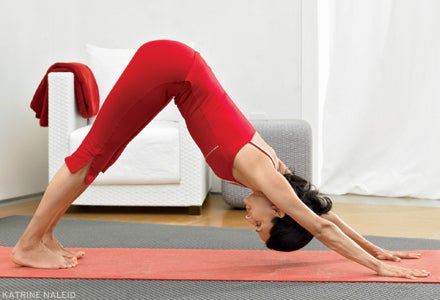
Building strength in the back of your body will give you the confidence to balance in the middle of the room. It will also teach you how to work your upper back and pelvis in an integrated way. Once you achieve that sense of integration, you will feel just as comfortable upside down as you do right side up.
Lie on your belly and tuck your toes under. Keeping your feet on the ground, lift your right hip and turn your right leg inward. Then lift your left hip and turn your left leg inward. Now relax your feet and inhale. Exhale and soften, open to the possibility of connecting to something bigger than you, to your true nature.
There are two arm variations to try. First, bring your arms by your sides with your palms facing each other. Lengthen the sides of your body and lift the heads of your arm bones toward the sky. Reach back through all of your fingers for three steady breaths. This pose opens your chest while strengthening your back. It is an excellent warm-up. Repeat several times before progressing to the next, more challenging variation.
For the second arm variation, interlace your fingers and place your hands on the back of your head. Press up against your hands as you inhale and exhale evenly. Give your head a little bit of resistance by isometrically pressing your hands down against your head. This will strengthen both your neck and back. As you stay for three to five deep breaths, use the inhalations to draw Muscular Energy into the core of your pelvis from the connection between your hands and head and from your feet and toes. On the exhalations, extend energy down through the tailbone, legs, feet, and toes and up through the top of your head. Allow the bottom tips of your shoulder blades to open your heart with generosity while you press your tailbone down firmly. When you turn upside down, these sensations in your body will act as a point of reference.
If your shoulders tend to be stiff, it is a good idea to practice both variations several times. Then try them again with your feet raised and legs extended. Notice the differences between the variations. You gain great benefits from all of them.
Wild Thing
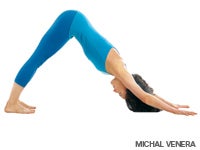
This playful pose opens your shoulders and strengthens your body, giving it a feeling of lightness. Begin on all fours. Place your hands shoulder-width apart. Spread your fingers evenly and align your wrist creases with the front edge of your sticky mat. Take a deep breath in and, as your rib cage expands, imagine it filling with light from within you. On your next inhalation, lengthen the sides of your body by moving your upper arm bones forward. Inhale again, and expand your light. Keeping that fullness in your upper body, exhale and soften your upper back to connect with the back of your heart.
Simultaneously lengthen your spine all the way down to your tailbone until it scoops under and lifts your abdominal muscles toward your spine.
Now tuck your toes under and stretch your legs for Adho Mukha Svanasana (Downward-Facing Dog Pose). Continue to press down firmly into the earth with your fingertips, palms, and knuckles, and generously support your arm bones by hugging your triceps toward the bone. Soften your heart gently and lengthen your spine, taking your sitting bones back and apart. Now scoop your tailbone again and send the strength generated in your pelvic core firmly down through your legs into your heels. In this very solid and balanced form of Downward-Facing Dog, take three slow breaths. When you remain connected to the power within and soften at the same time, you can create a balanced type of gentle strength in your body and peacefulness in your mind.
Inhale and stretch your right leg up in the air with enthusiasm that flows out and makes each individual toe shine with delight. Bend your right leg and reach it up and over the left side of your body until it lands gracefully on your mat. Your left foot will turn on its side, and your left leg will remain straight. You can land on either the sole or the ball of your right foot. Now inhale and draw Muscular Energy in from your hands, feet, arms, and legs, all the way into the core of your pelvis, and then shine out! Scoop your tailbone and lift your pelvis toward the sky as you extend strong, supportive Organic Energy from your pelvic core back down into the earth through both legs. The higher you lift toward the sky, the easier it will be to curl your head back and open your heart with joyful freedom and a playfulness that makes your heart sing. Keeping your connection to your midline, return to Downward-Facing Dog and then repeat on the other side.
Adho Mukha Vrksasana (Handstand), variation
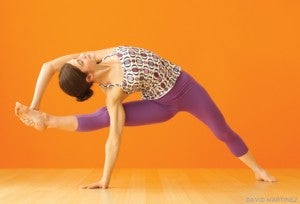
This variation of Handstand will strengthen and prepare your upper back for true heart opening without overstretching or irritating your shoulder muscles. By taking your hips to the wall, you’ll find it easier to move your arm bones toward the wall, too, which will keep them safely connected to the shoulder sockets. To begin, come onto all fours. Spread your fingers evenly and place your hands about eight inches away from a wall. As you press the pads of your fingers and your knuckles firmly into the floor, make a commitment to connect with your own inner power. Hug your muscles firmly to the bones and draw in to the midline of your body with straight arms, bringing more weight to your inner hands. Be steadfast in your commitment to keep your hands and arms firmly planted like this so they will not move when you kick up to the wall.
Come into Downward Dog. Then inhale, expand your torso from within, and lengthen the sides of your body generously. Exhale and soften your heart as you allow your upper spine to melt a little between your shoulder blades. Inhale, lift your hips, and walk a little closer to the wall. Exhale and scoop your tailbone, strongly engaging your abdominal muscles. Keeping all of this power, inhale and kick up one straight leg at a time and rest your heels and hips lightly against the wall. If you are tight, you might find it difficult to take your thighs back all the way, so use good judgment and don’t strain yourself to get there.
Once you are up, inhale and then curl your head back until you are looking at your hands. Again, take your arm bones back toward the wall. Exhale, and then press your upper spine and the bottom tips of your shoulder blades in toward the back of your heart.
Repeat these actions a few times: Keep curling your neck and head back as you move deeper into the back of your heart with steadfast graceful awareness. Inhale and hug your muscles in as you take your arms toward the wall. Exhale and keep the connection between the foundation of your hands and arms and the back of your heart. Then push the bottom tips of your shoulder blades into your upper back to continue opening your heart, moving it toward the center of the room. If you have hypermobile shoulders, don’t push into your armpits. Instead, focus on moving your arm bones toward the wall while scooping your tailbone. This will keep you from collapsing your shoulders and lower back. It will help you retain stability while creating more freedom. Beware of melting the heart too deeply.
It takes tremendous awareness to be truly open hearted. This work is profound and can inspire a shift in the way you interact with others. Repeat this asana two or three times, holding for 10 breaths each time.
Pincha Mayurasana (Forearm Balance), preparation
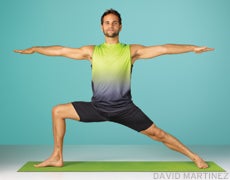
Practicing this one-legged version is the fastest way to gain the strength and flexibility you need to feel completely comfortable and stable in the middle of the room. You’ll combine all that you’ve learned in the previous poses. You will set a strong, stable foundation in the hands and arms. You will connect that foundation to your heart by pressing the bottom tips of your shoulder blades against your back. And you will connect your heart to the pelvic core by drawing the tailbone toward the heels and feeling the pelvic floor rebound up into your body.
From there you will reach up through your legs and feet with grace. This powerful upward reaching action will help give your entire body and mind the lightness of the peacock’s tail feather.
Begin kneeling and place your forearms on the floor, shoulder-width apart. Inhale and expand inside; exhale and soften with self-reverence. Allow your head to hang and lengthen the sides of your body.
Pressing down firmly with your hands and fingers, inhale and draw the heads of your arm bones into your shoulder sockets. Exhale and move the bottom tips of your shoulder blades deep into the back of your heart. Tuck your toes under, and take your groins back and apart as you lift your hips to the sky.
Root down from your tailbone through your right leg as you stretch your left leg upward. As you do this, keep your tailbone scooped to engage your abdominal muscles. This is key for learning how to balance upside down in the middle of the room. In essence, you are training yourself to understand that when your legs are extending upward, your entire core—which encompasses your heart and your abdomen—is actively engaged and plugged in. All parts of you are working together to form a unified whole. When you feel completely integrated from your foundation into your heart and from your heart all the way through your legs, feet, and toes, you will be able to reach out with strength and confidence, celebrating your own freedom and power. Release your left leg and repeat the pose, lifting your right leg. Practice this asana at least twice on each side.
Pincha Mayurasana (Forearm Balance)
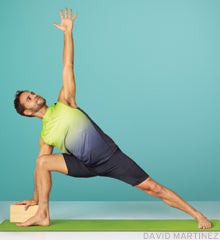
Above all else, learning to balance on your forearms in the middle of the room requires self-study and practice over a long period of time. The transformation happens slowly, and it brings a quality of peace and lightness to body, mind, and heart. But there is one benchmark that will help you know if you are ready to balance in the middle of the room: When you are in the preparatory pose, with your forearms on the ground, you must be able to walk your feet in toward your arms and place your pelvis directly over your open heart. If you’re not able to do that, it is too soon to expect that you will feel completely stable in the middle of the room without collapsing your lower back.
If you would like to balance using the wall, set up the pose with your fingertips close to the wall. If you would like to play with balancing on your own, start by placing your fingertips 6 to 12 inches away from the wall. This will give you the security of having the wall nearby and will prevent you from completely falling over and wasting energy. Eventually you will just know when you feel strong enough to kick up in the center of the room. Still, it’s always best to start by having a friend nearby to spot you.
From a kneeling position, place your forearms shoulder-width apart and spread your fingers evenly. You create the foundation of your pose with your hands and fingers—in any inversion, the pose is only as secure as its foundation is strong and steady. Inhale and press your hands, fingers, and knuckles down into the earth. Without moving your forearms, isometrically hug them to your midline to strengthen your inner arms.
Inhale and lengthen your side body. Exhale and gently soften your heart, allowing the dorsal spine to descend between your shoulder blades. Curl your head back to deepen the connection to your heart. This is the place where magic happens. When you take time to connect and keep your awareness in the heart, your perception will shift and transform into a more beautiful and gentle expression of the pose. Tuck your toes under and lift your hips. Take a few steps in. See if you can maintain the connection to your heart as you walk in toward your foundation. If not, then simply start over. You may begin again and again if necessary.
Next, raise one leg while maintaining the strong connection from your fingers all the way through your body to your toes. Inhale and engage all of your muscles. Exhale and lengthen, stretching with brightness and inner power. As you extend the raised leg, scoop your tailbone so that you can engage your abdomen. Keeping it engaged, inhale and kick up gently. Gradually you must learn how much or how little force you need to find your balance when you kick up. The stronger and more connected you are in your own center, the less force you will need to go upside down. If you fall toward the wall when you kick up, just bend one knee and place your foot on the wall behind you. Keep working on lengthening and strengthening your hamstrings, and soon you will be able to float up with great ease.
Once you are up, extend fully from the core through the heels. The more you extend, the lighter you’ll feel. If you become forgetful or dull about what you’re doing, the lightness of the pose will turn to heaviness and the fear will set in. Curl your head back and connect with your heart as you inhale, then press into the back of your heart with the bottom tips of your shoulder blades as you exhale and reach up.
Try the pose a few times, but don’t overdo it. Allow your body to absorb what it has learned and try again tomorrow. To cool down, do a series of forward bends like Uttanasana (Standing Forward Bend), Paschimottanasana (Seated Forward Bend), and Janu Sirsasana (Head-of-the-Knee Pose). Take the seated twist Ardha Matsyendrasana (Half Lord of the Fishes Pose) to unwind the spine.
The strength and flexibility you gain from attempting more-advanced poses such as Pincha Mayurasana can have a profound effect on your self-awareness and confidence. When you begin to know how much power you possess and realize that you have the ability to connect to it at will, you will be able to release your mind from the grip of negative emotions, including fear, much more quickly. You will be able to celebrate the lightness of heart that is your birthright, and you will begin to enjoy each day more fully.